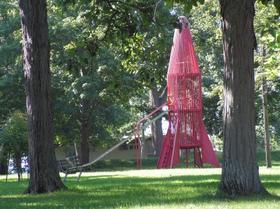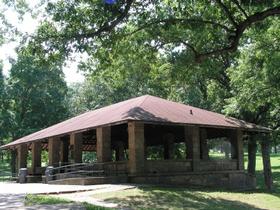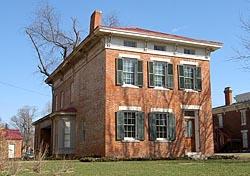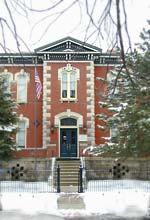By Jacqueline Covey
Staff Reporter
PHOTO/ JACQUELINE COVEY/THE VOICE
Tim Schroll, property owner of Moses King Brick and Tile National Historic District, shows the roof of the factory beginning to weigh down. May 31 was the end date of a 90-day fundraiser
to buy materials to fix the roof.
COLCHESTER — Moses King Brick and Tile National Historic District made its goal to rework support and structural impairments after a 90-day fundraiser.
Dev, and her husband Tim Schroll, hit the $10,000 mark by midnight on May 31 to reverse dipping in — among other infrastructural remedies to — the factory roof.
By May 29, two days before the fundraising cutoff, the Brickyard had received 76 percent of funds needed, according to Schroll.
It was then a couple reached out to Schroll and Dev, saying they'd put up whatever was left on midnight on the end date.
"In fact, we got the check today," Schroll said on Monday.
Nearly 60 individual donations, varying in size: $10, $50, $100 and "a few" $1,000, came in to help repair the 1924 factory building. The monies came from locals, tri-county residents,
regionals, and a few crossing state boarders.
Schroll said that recently he had the structure work estimated, which came out to be $28,000.
Realizing that amount of money wouldn't be realistic to raise, Schroll said he figured if he could get the materials covered, he could depend on volunteers.
"We've always had good volunteer people," he said. "People come out here and get dirty and help and do."
What the project needs exceeded the capabilities of the maintenance fund, Schroll said, as the Brickyard already struggles with that funding.
However, because the King family sold the property to Schroll and Dev, he said they do not need to jump through state and federal historically-correct hoops to rehabilitate the
roof.
"Now, what were trying to do is we're trying to get it (right)," Schroll said on the contrary. "We're going to go back to the metal roofing, which we believe it originally had on it, so it
looks historically correct instead of shingles."
The shingles that currently cover the structure have expired their 20-year shelf life. Schroll said that volunteers helped with that effort back then, but he added "that's one
thing."
He hopes to "round up" experienced contractors, as well as ready hands, to bring the roof back to its original shape. He stressed finding someone who knows repairing structures to ensure the
factory remains sound.
Schroll and other historical sitings in the area have had conversations about a tourism trail that would take people to places like the Carthage jail or Nauvoo.
"But we can't do that until its safe," Schroll said.
Moses King purchased the land in 1876 hoping to use the land to mine coal. King's $150 parcel produced a considerable amount of excess coal, and he used what he could not sell to fire clay
into brick.
And so began the family business.
In 1884, King put in his first two kilns. These massive bee-hive structures were able to reach upwards of 2,000 degrees to dry the clay bricks.
However, on St. Patricks Day, about 15 years ago, according to Schroll, one of the eventual seven kilns that King would build "exploded." While in the house, Dev and Schroll heard a loud
snap, followed by what sounded like bricks collapsing.
"It was worn, the last band broke, and it turned into a pile quarter of a million bricks," Schroll said.
"Just like that, two seconds," he added.
The original kilns are still holding, but not strong.
"This is a whole separate world when it comes to fundraising," Schroll said.
Schroll and Dev have devoted themselves to the Brickyard, and Schroll said he has no idea why. Though, he said, it's Dev's passion, and to her it's worth it.
"She saw beauty in it," Schroll said.
The Brickyard has become a sort of sanctuary for those looking for one. People would take tours, work on art in the workshops, visit in the short-stay rooms, and contribute to the district’s
lawn.
Upon entering the brick-firing area, a "spiral" filed with burned, destroyed old bricks, glass bits from the furnace, and other small treasures lead the walker to "Mother Bear" – a concrete
bear statue.
Schroll wishes to restore the Brickyard, and help it further its own peculiar history.
"The liability is just scary," Schroll said.
On Monday, at the time of the interview, decent-seized patch of ground between the 1884 kilns stood concaved.
Despite the work that still needs to be done, the factory is well on its way to being refurbished. Fixing up the 139-year-old historical district is a long strenuous take-on.
Schroll, though, said that the place had its hold on him, and he and his wife will continue their work on it.
Reach Jacqueline Covey via email at jcovey@McDonoughVoice.com, or follow her on Twitter @jacquelinecovey.






















